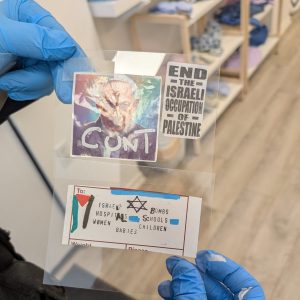After a tumultuous week at York University over a mural hanging in the school’s student centre that some argue promotes violence toward Israel, university president Mamdouh Shoukri issued a statement intended to calm tensions at the school.
“It is clear that the subject of the artwork is offensive to some individuals and groups, particularly Jewish members of our community,” Shoukri wrote in a statement issued Jan. 29. “The mural has given rise to a broader conversation about whether, as an institution and as individuals, we are doing all we can to ensure that all members of our community feel welcome and supported.”

The school will form a President’s Advisory Committee on Inclusion to “ensure inclusive respectful exchange of ideas, particularly on social and political issues,” the statement said.
As well, the university is reviewing its policies to “better foster and protect an inclusive and positive learning environment.” The process will include looking at the rules for student groups and organizations. The entire review is to be completed by the end of the year.
Shoukri’s statement came in response to a decision last week by media mogul Paul Bronfman to withdraw his support for York’s film and creative programs over the controversial mural.
Debate about the artwork, which has been covered widely in the media, has also brought into focus long-standing complaints about anti-Israel and anti-Semitic tensions at the university.
“As a Canadian, never mind as a Jew, the fact the administration would allow this piece of garbage to be displayed in a student lounge… This is something concrete I could point to and say, ‘Take that thing down or you’ll lose our support,’” Bronfman told The CJN.
As chair of Pinewood Toronto Studios and William F. White International, a supplier of film equipment and expertise, Bronfman has donated thousands of dollars worth of production equipment, invited students to open houses and offered seminars, learning labs and technical training to students in York’s programs.
READ: HOW BAD IS IT ON CAMPUS? DEPENDS WHOM YOU ASK
The painting in question, titled Palestinian Roots, was a winner in a student art contest and has hung in the student centre since 2013. It depicts a man holding rocks looking at a field and a bulldozer. On his back is a Palestinian flag and a map of Israel. Underneath the painting are the words “justice” and “peace” in several languages.
Bronfman, a director of the Friends of Simon Wiesenthal Center for Holocaust Studies (FSWC), learned about the painting recently when the organization’s CEO, Avi Benlolo, highlighted it in an email to supporters. Bronfman spoke with Shoukri and other senior administrators before making his decision, but he said their responses were inadequate.
“Their position is indefensible. It’s a bunch of political, bureaucratic rhetoric. That’s all I got from the president himself,” he said. “It was just a bunch of legal nonsense and jargon.”
Shoukri dropped into York’s Hillel offices Jan. 27 and spoke informally with students for about an hour, said Anna Baev, director of Hillel York.
“He was very sympathetic. He understood their perspective,” Baev said. “It made them feel that they are being heard.”
Many of the conversations were about the mural, and Shoukri stressed that the painting hangs in the York student centre and does not fall under the university’s control.
In an earlier statement, the university wrote that it consulted with legal experts and concluded it could not compel the student centre to remove the painting.
Hillel has written to the student centre previously, and York’s Hillel student president Natalie Slavat wrote an open letter to executive director Scott Jarvis, which was published in the Times of Israel Jan. 27, asking for the mural to be removed. Representatives of the student centre have not responded to Hillel, Baev said.
A spokesperson for the student centre also did not respond to The CJN’s phone calls or emails.
In an email to the Globe and Mail, Gayle McFadden, the centre’s vice-president of operations, said, “This artwork is not hateful and is the artist’s depiction of the resistance to the occupation of Palestinian land.
“This painting is not anti-Semitic, as it is merely critical of the State of Israel and its continued occupation of Palestine.”
In an earlier statement, the university said it “remains firmly committed to its values of freedom of expression, open dialogue and constructive discussion.”
“We deeply regret Mr. Bronfman’s decision and would like to thank him for his support. Our arts, media, performance and design students have benefited from the experiential learning activities made possible by his generosity,” the university’s statement concluded.
READ: WATERLOO STUDENTS VOTE NO TO BOYCOTT OF ISRAELI UNIVERSITIES
Hillel Ontario noted that according to the student centre art contest’s own guidelines, the picture was only supposed to be on display for two years.
“Hillel has continued to stress to the university administration that we are deeply disturbed by the ongoing display of this mural,” Hillel Ontario CEO Marc Newburgh said in a statement.
The Centre for Israel and Jewish Affairs (CIJA) concurred that the painting should have come down long ago.
“It is unfortunate that that the irresponsible decision of the student centre has put film students at York at a tremendous disadvantage, as they will no longer benefit from the multiple resources contributed by this generous donor,” said Joel Reitman, CIJA’s GTA co-chair.
Bronfman agreed York’s students will bear the brunt of his decision, but said they can “blame the faculty, right up to the president.
“The tone in my company is set by me. The tone of that university is set by the president.”






